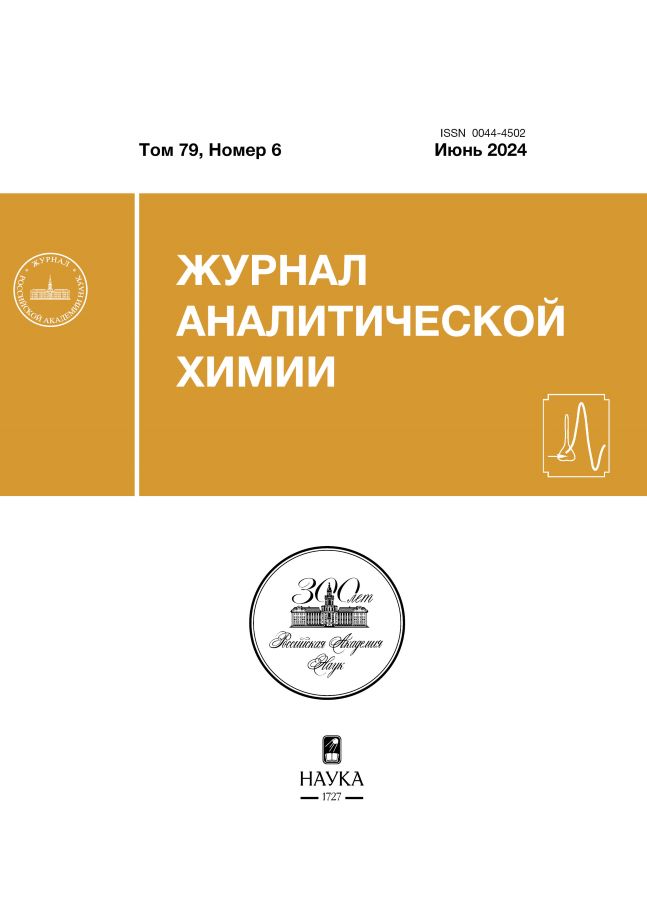Determination of norfloxacin by sensitized terbium fluorescence in the presence of silver nanoparticles and surfactant micelles
- Авторлар: Smirnova T.D.1, Alyabyeva E.A.1, Yurasov N.A.1
-
Мекемелер:
- Saratov National Research State University named after N. G. Chernyshevsky
- Шығарылым: Том 79, № 6 (2024)
- Беттер: 668-676
- Бөлім: ORIGINAL ARTICLES
- ##submission.dateSubmitted##: 31.01.2025
- URL: https://snv63.ru/0044-4502/article/view/650214
- DOI: https://doi.org/10.31857/S0044450224050098
- EDN: https://elibrary.ru/usrhcj
- ID: 650214
Дәйексөз келтіру
Аннотация
The influence of silver nanoparticles and surfactant micelles on the signal intensity of the sensitized fluorescence of the norfloxacin complex with the Tb3+ ion was studied. It was shown that the intensity of the intrinsic fluorescence of norfloxacin and its complex with Tb3+ ions slightly decreases in the presence of silver nanoparticles. It was found that the presence of dodecyl sulfate micelles leads to the modification of the silver nanoparticle surface, which is accompanied by a change in the ζ-potential of the nanoclusters. The addition of surfactant-modified silver nanoparticles to aqueous solutions of terbium chelate increases the intensity of sensitized fluorescence by 11 times. The increase in the efficiency of intramolecular energy transfer in the Tb3+ complex with norfloxacin in the presence of silver nanoparticles and dodecyl sulfate micelles made it possible to propose a method for the fluorimetric determination of the antibiotic in natural water in the concentration range of 2 × 10-7 −1 × 10-5 M. The calibration graph equation is y = 1.0 × 107x − 1.0, R2 = 0.991, detection limit 5 × 10–8 M (3σ).
Негізгі сөздер
Толық мәтін
Авторлар туралы
T. Smirnova
Saratov National Research State University named after N. G. Chernyshevsky
Хат алмасуға жауапты Автор.
Email: smirnovatd@mail.ru
Institute of Chemistry
Ресей, 410012 SaratovE. Alyabyeva
Saratov National Research State University named after N. G. Chernyshevsky
Email: smirnovatd@mail.ru
Institute of Chemistry
Ресей, 410012 SaratovN. Yurasov
Saratov National Research State University named after N. G. Chernyshevsky
Email: smirnovatd@mail.ru
Institute of Chemistry
Ресей, 410012 SaratovӘдебиет тізімі
- Picó Y., Andreu V. Fluoroquinolones in soil-risks and challenges // Anal. Bioanal. Chem. 2007. V. 387. №4. P. 1287. https://doi.org/10.1007/s00216-006-0843-1
- Santigosa E., Maspoch S., Payán M.R. Liquid phase // . 2019. . P. 280.
- Tsanaktsidou E., Markopoulou C.K., Tzanavaras P.D., Zacharis C.K. Homogeneous liquid phase // Microchem. J. 2022. Article 106906.
- Samanidou V.F., Demetriou C.E., Papadoyannis I.N. Direct determination of four fluoroquinolones, enoxacin, norfloxacin, ofloxacin, and ciprofloxacin, in pharmaceuticals and blood serum by HPLC // Anal. Bioanal. Chem. 2003. V. 375. № 5. P. 623. https://doi.org/10.1007/s00216-003-1749-9
- Liu Y.M., J.T. Cao J.T., Tian W., Zheng Y.L. Determination of levofloxacin and norfloxacin by capillary electrophoresis with electro chemiluminescence detection and applications in human urine // Electrophoresis. 2008. V. 29. P. 3207. https://doi.org/10.1002/elps.200800048
- Rahman N., Ahmad Y., Azmi S.N.H. Kinetic spectrophotometric method for the determination of norfloxacin in pharmaceutical formulations // Eur. J. Pharm. Biopharm. 2004. V. 57. № 2. P. 359. https://doi.org/10.1016/S0939-6411(03)00192-9
- Thapliyal N., Karpoormath R.V., Goyal R.N. Electro analysis of anti tubercular drugs in pharmaceutical dosage forms and biological fluids // Anal. Chim. Acta. 2015. V. 853. P. 59. https://doi.org/10.1016/j.aca.2014.09.054
- Mohammadian E., Rahimpour E., Alizadeh-Sani M., Foroumadi A., Jouyban A. An overview on terbium sensitized based-optical sensors/ nanosensors for determination of pharmaceuticals // Appl. Spectrosc. Rev. 2022. V. 57. № 1. P. 39. https
- Штыков С.Н. Химический анализ в нанореакторах: основные понятия и применение // Журн. аналит. химии. 2002. № 10. С. 1018. (Shtykov S.N. Chemical analysis in nanoreactors: Main concepts and applications // J. Anal. Chem. 2002. V. 57. P. 859.) https://doi.org/10.1023/A:1020410605772
- Derayea S.M., Omar M.A., Hammad M.A., Hassan Y.F. Application of surface plasmon resonance of citrate capped silver nanoparticles for the selective determination of some fluoroquinolone drugs // J. App. Pharm. Sci. 2017. V. 7. № 2. P. 016. https://doi.org/10.7324/JAPS.2017.70203
- Jeong Y., Kook Y-M., Lee K., Koh W-G. Metal enhanced fluorescence (MEF) for biosensors: General approaches and a review of recent developments // Biosens. Bioelectron. 2018. V. 111. P. 102. https://doi.org/10.1016/j.bios.2018.04.007
- Wang H., Si X., Wu T., Wang P. Silver nanoparticles enhanced fluorescence for sensitive determination of fluoroquinolones in water solutions // Open Chem. 2019. V. 17. P. 884. https://doi.org/10.1515/chem-2019-0094
- Geddes C.D., Lakowicz J.R. Metal-enhanced fluorescence // J. Fluoresc. 2002. V. 12. P. 121. https://doi.org/10.1023/A:1016875709579
- Крутяков Ю.А., Кудринский А.А., Оленин А.Ю., Лисичкин Г.В. Синтез и свойства наночастиц серебра: достижения и перспективы // Успехи химии. 2008. T. 77. № 3. С. 242. (Krutyakov Yu. A., Kudrinskiy A. A., Olenin A. Yu., Lisichkin. G. V. Synthesis and properties of silver nanoparticles: advances and prospects // Russ. Chem. Rev. 2008. V. 77. № 3. P. 233.) https://doi.org/https://doi.org/10.1070/RC2008v077n03ABEH003751
- Uivarosi V. Metal complexes of quinolone antibiotics and their applications: An update // Molecules. 2013. V. 18. № 9. P. 11153. https://doi.org/10.3390/molecules180911153
- Ghosh D., Chattopadhyay N. Gold and silver nanoparticle based superquenching of fluorescence: A review // J. Lumin. 2015. V. 160. P. 223. https://doi.org/10.1016/
Қосымша файлдар

















